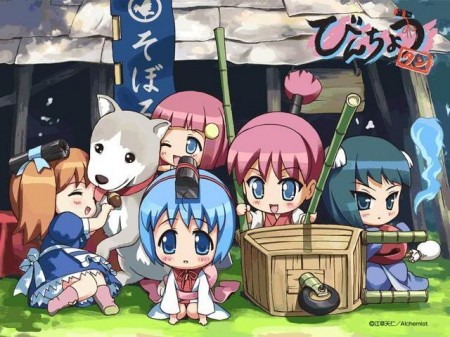Ask John: Could the U.S License Chibi-type Anime?
Question:
John what are your views a Chibi type anime known as ‘Bincho tan’ that can be pick up by a U.S licensor personally I have mixed feelings about the series because despite the levels of cuteness about the main character the show is clled a slice of life series and there are some scenes that can make you cry or feel sad literally! will this series about an orphan girl sell well overseas?
Answer:
The domestic market potential of “SD” (super-deformed) or “chibi” (small) anime is an odd, ironic thing because hardcore American anime fans – particularly girls – seem to adore “chibi” characters, but the vast majority of potential American viewers disregard “chibi” anime because it opposes the inherent attractiveness of anime. A vast number of American viewers are drawn to anime specifically because anime is sleek, chic, progressive, and simply cool. SD is a conscious parody of that coolness. Squat, stubby, misproportioned SD is the antithesis of the sleek, beautful and stylish design that Americans find so appealing about anime. So few SD anime have ever reached America, and none have ever been very successful.
AnimEigo released an “SD Double Feature” on domestic VHS, containing the 1988 Scramble Wars: Tsuppashiru! Genom Trophy Rally and Ten Little Gall Force OVAs. The former parodied AIC’s Bubblegum Crisis, Gall Force, and Genesis Survivor Gaiarth series. The later parodied the production of AIC’s Gall Force series. These two shorts are highly beloved among American “old-school” anime otaku, but these two shorts have practically no contemporary market potential domestically. In 1990 Japanese studio Sunrise pitched a American franchise titled “Doozybots” to American networks. The show was a (thankfully) never picked-up original franchise featuring SD Gundam robots.
Sunrise later co-produced the SD Gundam Force television series for American and Japanese broadcast. While the show became part of a long line of SD Gundam anime available in Japan, it’s been one of the very few SD anime formally released in America, where it was not successful. The SD Suzumiya Haruhi-chan anime series has officially released in America, initially online, followed by a DVD release, to seemingly very limited success. Other “chibi” or SD anime including Chibi Go Nagai World, Choro Q Dougram, Kamen Rider SD, DD Hokuto no Ken, Tachumaru Gekijou, Chou Mashin Eiyuden Wataru, and Ryu Knight have never been formally released in America. The “chibi” OVA series Dragon Half was quite successful in America while it was available, but that success may be attributed more to the show’s humor than its visual design.
The 2006 Binchou-tan television series is a bit of an oddity because it looks like a “chibi” anime while it’s actually an “iyashi-kei” calming-type anime. This peaceful, charming slice-of-life drama about a poor orphan girl who strives to maintain a positive attitude and make friends was seemingly most popular among Japanese middle-aged men rather than typical teen and young adult otaku. Iyashi-kei anime, most noteably the Aria the Animation franchise, have reached America. But iyashi-kei style alone is a tough sell to average American consumers that want exciting, funny, and romantic stylish and trendy anime. Compounding iyashi-kei pacing with “chibi” characters is almost certain to doom an anime series to marginal cult support in America. I’ve been a fan of creator Takahito Ekusa’s Binchou-tan characters since their debut in 2003 (I own two Binchou-tan figures), and I remain a very favorable fan of the 2006 anime television series. However, while I’d love to see this sweetly adorable series reach official American media, I have to accept that American viewers simply aren’t as receptive to the whole spectrum of anime that Japanese viewers appreciate. While entire SD or “chibi” anime series are viable in Japan, they’re not commercially viable in America.
Add a Comment
You must be logged in to post a comment.



Holy crap, DoozyBots couldn’t be more early ninties if it tried. Sports, surfers, and a character with a handicap. Actually, I would have loved to see this. What’s up with that title, though?
SD Double Feature was amazing; I can’t believe Animiego didn’t make the jump to DVD on that one. The VHS fetches a hefty price.
A number of years ago AnimEigo confirmed that unfortunately they were unable to negotiate an acquisition of DVD distribution rights.
I guess chibi/SD character designs suggest the show will be comedic or otherwise insubstantial. Lucky Star, with its semi-SD proportions, can be considered a successful one, but it certainly fits the mold of being comedic and insubstantial.
There’s so much SD integrated into the storytelling of otherwise non-SD anime, I don’t feel the need for exclusively SD anime. Kimi ni Todoke as a recent example makes very generous use of SD variants for comedic, and even dramatic scenes.